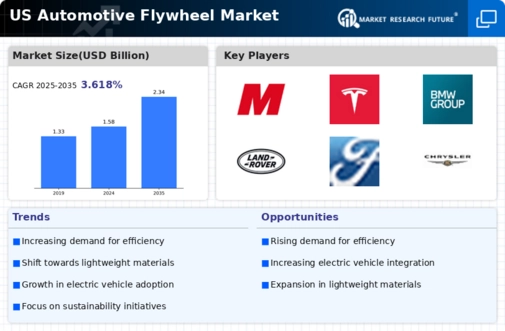Enhanced Performance Requirements
The automotive flywheel market is influenced by the growing demand for enhanced performance in vehicles. Consumers are increasingly seeking vehicles that offer superior acceleration, handling, and overall driving experience. Flywheel systems play a crucial role in achieving these performance metrics by providing rapid energy storage and release capabilities. In 2025, it is estimated that performance-oriented vehicles will represent around 30% of the automotive market in the US. This shift is prompting manufacturers to invest in innovative flywheel technologies that can deliver the necessary power and efficiency, thereby propelling the automotive flywheel market forward.
Rising Adoption of Hybrid Vehicles
The market is experiencing a notable surge due to the increasing adoption of hybrid vehicles in the US. As consumers become more environmentally conscious, manufacturers are integrating flywheel technology to enhance fuel efficiency and reduce emissions. In 2025, hybrid vehicle sales are projected to account for approximately 25% of total vehicle sales in the US, driving demand for advanced flywheel systems. These systems provide a means to store energy generated during braking, which can be reused to improve overall vehicle performance. Consequently, the automotive flywheel market is likely to benefit from this trend, as automakers seek to meet consumer expectations for greener alternatives.
Increased Focus on Lightweight Materials
The market is benefiting from the industry's shift towards lightweight materials. As manufacturers strive to improve fuel efficiency and reduce emissions, the use of lighter components has become a priority. Flywheels made from advanced materials such as carbon fiber and aluminum are gaining traction due to their ability to reduce overall vehicle weight while maintaining performance. In 2025, it is anticipated that lightweight materials will constitute approximately 40% of the total materials used in vehicle production in the US. This trend is likely to enhance the appeal of flywheel systems, as they align with the broader industry goals of sustainability and efficiency.
Technological Innovations in Energy Recovery Systems
The market is being propelled by technological innovations in energy recovery systems. As manufacturers seek to enhance vehicle efficiency, the integration of flywheel systems for energy recovery during braking is becoming increasingly prevalent. These systems can capture kinetic energy and convert it into usable power, thereby improving overall vehicle efficiency. In 2025, it is projected that energy recovery systems will be implemented in approximately 20% of new vehicles sold in the US. This trend indicates a growing recognition of the benefits of flywheel technology, positioning the automotive flywheel market for substantial growth in the coming years.
Growing Investment in Electric Vehicle Infrastructure
The market is poised for growth as investments in electric vehicle (EV) infrastructure continue to expand in the US. With the increasing number of EVs on the road, there is a corresponding need for efficient energy storage solutions. Flywheel technology offers a promising alternative for energy storage, particularly in charging stations and grid applications. In 2025, the US is expected to see a 50% increase in the number of public charging stations, creating a favorable environment for the adoption of flywheel systems. This investment in infrastructure is likely to drive demand for automotive flywheels, as they provide a reliable means of energy management.



















Leave a Comment